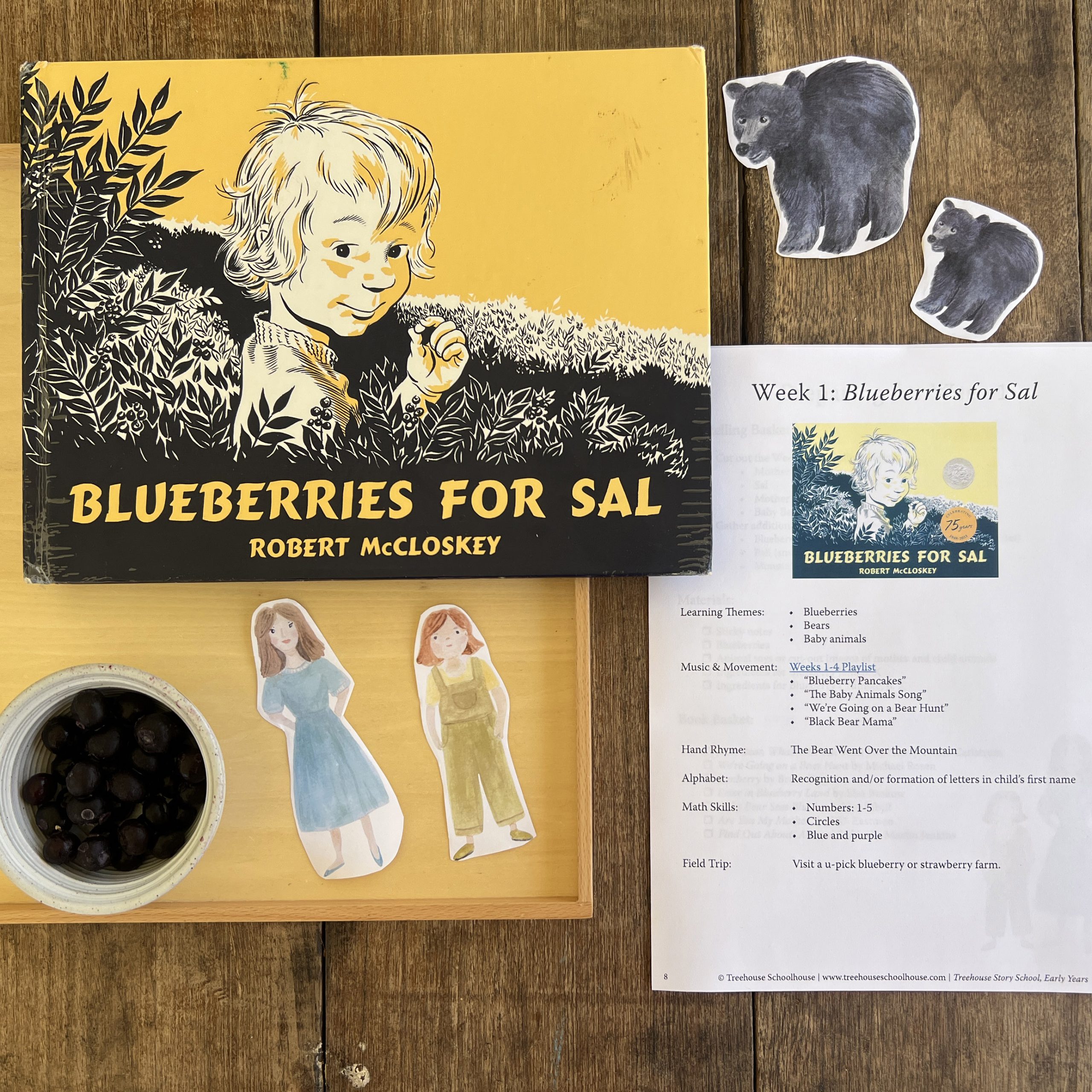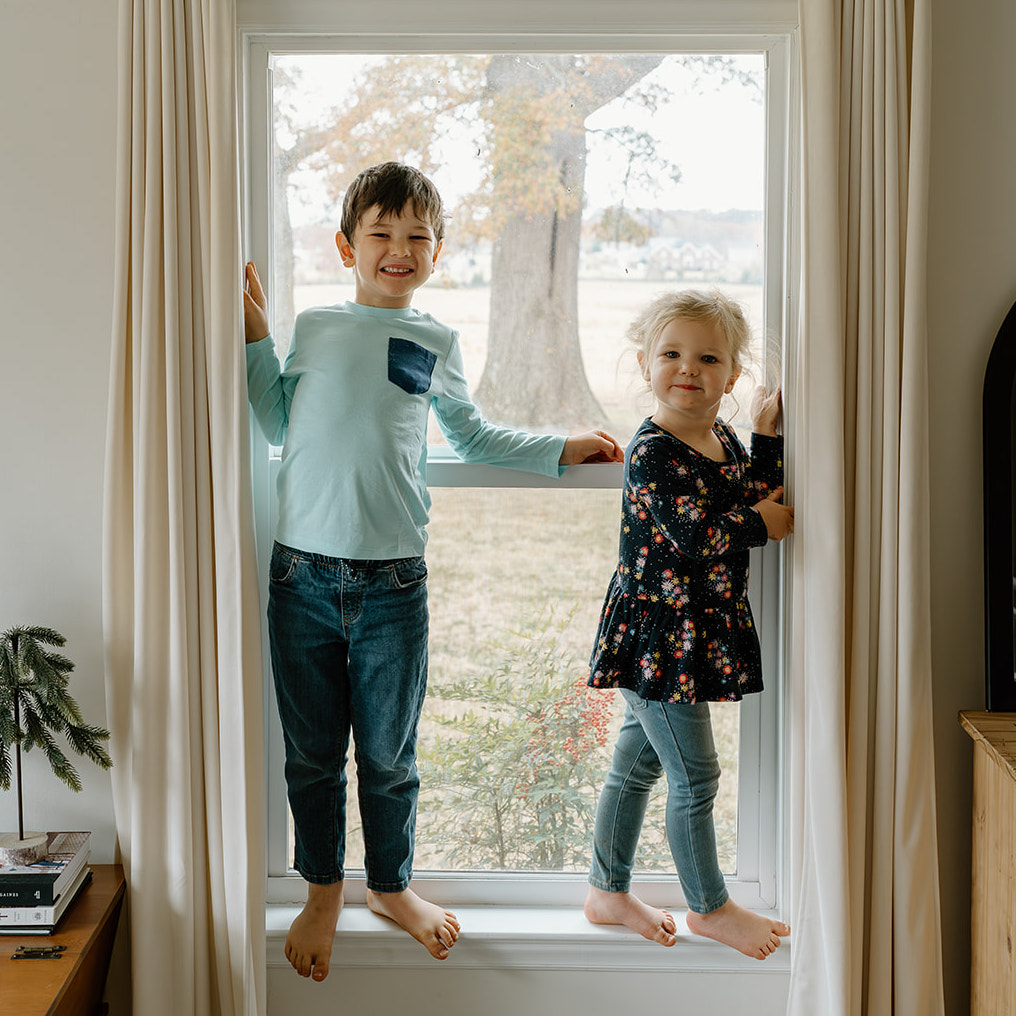When my older two children were preschool-age, I began researching homeschooling methods and became really excited about our future lifestyle of home education. I was tempted to decorate my house like a preschool classroom and start teaching how to read and write!
Thankfully, I read a lot of inspiring information about delaying formal education and decided early on that we wouldn’t push academics in those early years. I also learned I didn’t need our home to ever look like or feel like a classroom. I realized there are much more important things to focus on in the ages between 2-6. In this blog post, I am sharing what we focus on in the early years of education for our family.
Over time, I developed a priority list to help me set up our days with intention and evaluate if my young children are getting the childhood I believe is best for them, while preparing them for the formal schooling years down the road.
I’ve discovered that although these intentions don’t require having a formal curriculum, they do require cultivating an environment and family culture that naturally incorporates them into our daily routines. While a curriculum might not be essential, having a general guide can be invaluable in ensuring these aspects remain a priority. After guiding my four children through their preschool years, I spent years developing a gentle curriculum designed to help seamlessly integrate these intentions into your everyday life.
In this blog post:
- Homeschool Preschool: Five intentions for the early years
- What about academics in the early years?
- Using Treehouse Story School: Preschool to guide early learning
- Beloved early learning resources from Treehouse Schoolhouse
Five intentions for the early years
Here are my guiding principles for the early years, when children are between ages 2-6.
Intention #1: Fostering a deep love for living literature

This is central to so much of our lifestyle. I learned early on that books and stories were going to be a huge part of our life as a homeschool family. I knew I wanted to start training my eye to find quality living books and get as many rich stories in front of my children as possible, starting at an early age.
Let me say this more clearly – reading aloud to children early and often is so important, but what we are reading to them is equally as important. I choose to offer my children living books as often as possible. A living book is one that leaves the reader and/or listener inspired and sparks their curiosity and imagination. Living books are often written by someone who has imagined or experienced the content of the story first-hand. If the book is factual in content, the facts are presented in a way that the reader feels as though they are “in” the story.
For example, it is autumn and you want to read your children books about apples. You could choose to read science books that tell facts about apples to your child in plain language, like a textbook. Or, you could read a story of a child who goes apple picking with their grandfather and comes home to make apple pie. In the story, the child learns about the apple’s life cycle and the parts of the apple (and so does your child as you read together). Which book would be more memorable to your child? More enjoyable to read? Which would cause your child to want to experience apple picking for themselves? That one is likely a living book.
How we implement this:
- Reading aloud – I make it a priority to read aloud every day to my preschool-aged children. I keep books in nearly every room of our house to make books easy to grab at any time. We read classics, poetry, new picture books we find at the library or on book lists, and some early chapter books like Charlotte’s Web or Winnie the Pooh. With our preschool curriculum, Treehouse Story School: Preschool, we focus on one picture book and the themes found in that book each week. We read the main story everyday and rotate in other picture books that coordinate. For example, we may read Blueberries for Sal by Robert McClosky each day and add in more books about bears, blueberries, Maine, and baby animals throughout the week. All of the book titles and additional lists are found in the curriculum.
- Audiobooks, podcasts, and read-along books – Around age 2, my children listen to stories for hours each day. This is usually in the car, while they eat, or while they play with things like play-dough or magnatiles. As they get older, they learn to follow along in books which I have seen really help in their early desire and ability to read. Our most used resources for this are audiobooks through free library apps such as Hoopla. Next in line would be story podcasts. Check out this post and this post for my favorite story podcasts. Read-along books take practice, which we start around age 3-4. These are either books with coordinating CDs or more recently I have discovered Wonderbooks, which have the audio embedded in them and are a complete game changer. I get these from my library. There are other ways to listen to stories, one I have seen become popular lately, but we haven’t tried yet is the Yoto player.
- Book club play dates – When my older children were preschool-age, I started a preschool book club with some friends. We would choose one picture book and read it to our children and then gather to “celebrate” the book with activities, snacks, and games. Talk about helping children fall in love with literature! This idea grew into early chapter books over time and is what inspired Treehouse Book Studies. If you have older preschoolers or kindergarteners, I recommend trying this by using a book study like Charlotte’s Web, My Father’s Dragon, or The Trumpet of the Swan. These guides include ideas for hosting a book club meet up with friends.
- Play-based narration – Narration is at the core of a Charlotte Mason education. I decided early on that I would start practicing this skill with my little ones in a gentle way before formal lessons to prepare them. To encourage this, I read good literature and offer “props” for them to play the story. Treehouse Story School: Preschool, includes watercolor-illustrated cut-out pieces for each weekly story and a list of prop ideas to include so your child can “play the story!”
Intention #2: Encouraging unstructured, creative play
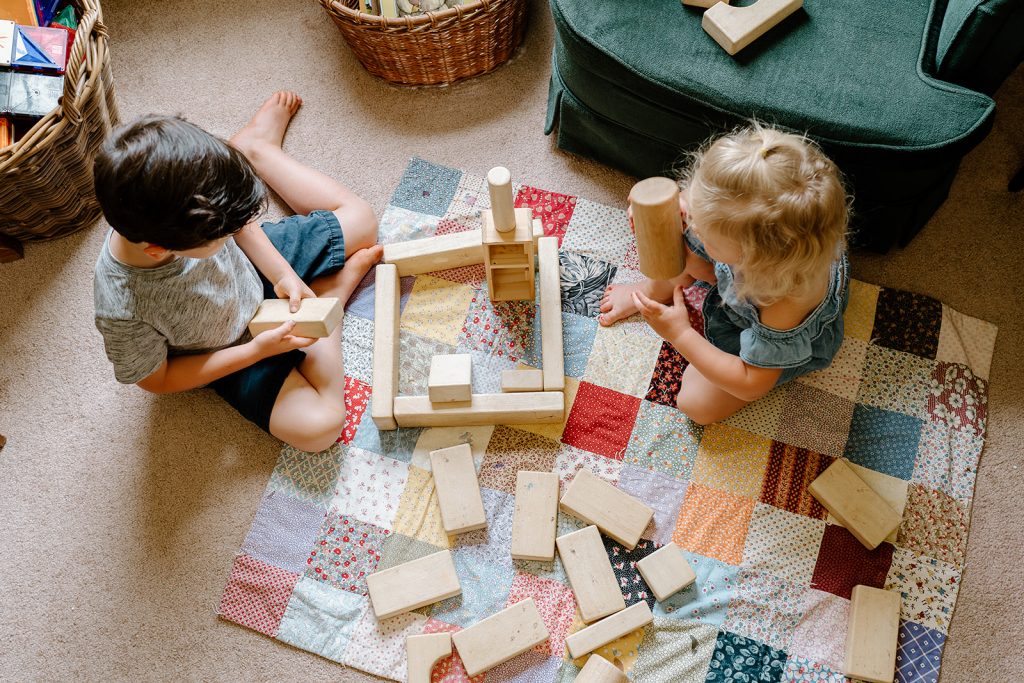
It seems obvious to some that prioritizing play is an important element to the early years, but it really is the type of play that matters. All children play, but the type of toys and their environment will deeply impact the type of play they engage in, which affects their development, imagination, critical thinking skills, and more. In our home, the goal is lots and lots of unstructured and creative play in the early years.
How we implement this:
- Margin in our schedule – Children need lots of time to be bored to encourage imaginative play. What this looks like for us is not entertaining them myself, under-scheduling our days, and giving them lots of free time. Not only do I not over-schedule my little ones with programs and plans, but I also don’t over-schedule my older children so we aren’t running around in the car every day. As far as not entertaining them, what I mean is that while I set the environment and offer ideas throughout the day, I don’t have activities planned out for them very often at all. I will jump in and help get their creativity going, but then I walk away and encourage their own creativity to keep the play going.
- Minimal screentime – I am not 100% anti-screen, but I do believe that too much time watching shows and playing games on screens affects their imaginations and ability to be creative. We are very minimal with screentime to give all of our children the time and ability to play creatively. When they do have screentime, we opt for low-stimulation shows like Little Bear or Scholastic Storybook Treasures. (It’s a bonus if the show connects back to the literature to reinforce that connection and love of books!)
- Open-ended toys – The next piece is what toys we offer them. Open-ended toys are toys that allow children to express themselves freely and creatively. They encourage the type of play where there are no rules to follow and no pressure to produce a specific, finished product. We have a minimal amount of toys and avoid any toys that tell the child exactly how to play with them. Aside from toys, we keep a lot of “loose part” type of objects around for creative, imaginative play, including craft supplies like clay and paint, cardboard boxes, sticks, rocks.
- Keeping toys to a minimum – The habit of attention is attained by children slowing down their minds and focusing on one thing at a time. When children have too many options in their environment, it becomes a challenge to focus on anything. Even if you own a lot of toys, implementing a rotation system to offer less at a time can help a lot. We keep only two or three toy category options at a time in the area they are playing.
Intention #3: Intentional training through a connected relationship

Homeschooling is an extension of parenting. I believe that before children are of formal schooling age, we need to prepare them to listen and follow instructions from us as their parents. We need to build that trust relationship where they heed our direction.
How we implement this:
- Clear direction and consistent follow-through – The best way to set our children up to succeed is by giving clear directions and coming alongside them to help them follow the directions given. We show and tell them exactly what is expected of them and make sure it’s attainable before holding them accountable to it. Once we know that they understand and are able to follow instructions, they will receive correction for choosing not to follow instructions. Even as they get older, I try to only give my children the number of tasks at one time that I know they can handle. Then, I do my best to follow up with the tasks and correct them if it is unfinished or praise them for finishing them. When we “rapid fire” our children with instructions, we overwhelm them and they give up trying to focus on what they were asked to do. When we don’t follow up with what we asked of them, we communicate that it doesn’t matter if they pay attention anyway.
- Building in time for connection – Sometimes preschoolers can fall through the cracks when you are schooling older children or if you are not yet feeling the need to engage in formal schooling. Let me encourage you to schedule times to cuddle, play, read aloud, and cook together. These days go fast and homeschooling in the formal years will go so much smoother if it’s rooted in a deep connection.
Intention #4: Opportunities to learn practical life skills

Learning skills like cooking, gardening, household chores, and caring for their environment strengthen children’s habits of attention and are a great opportunity to develop motor control and coordination, independence, concentration, and a sense of responsibility. My favorite reason of all to give children these opportunities is for relationship building. We spend so much time baking and doing everyday chores together when they are little and those moments are some of my favorite memories!
How we implement this:
- Daily chores – Young children love feeling capable and independent. We start giving our children chores using these chore charts around age 3. We complete tasks together and they get to check them off the list using a dry-erase marker. Some chores I may put on my children’s lists between ages 2-5 are getting dressed, wiping the table, or making their bed. Along with this, I invite my little ones into my chores on a daily basis. They help switch laundry, empty bathroom trash cans, sweep, and unload dishes. It often takes more effort to have a “helper,” but it is worth it when you think of what it is doing for their development.
- Cooking together – Every opportunity I get, I invite my little ones into the kitchen with me to crack eggs, stir, pour, measure, and even chop using these knives. Treehouse Story School: Preschool includes opportunities for children to learn practical life skills, motor skills, and simple child-friendly recipes in each week of study.
Intention #5: Time and space for experiences in the outdoors
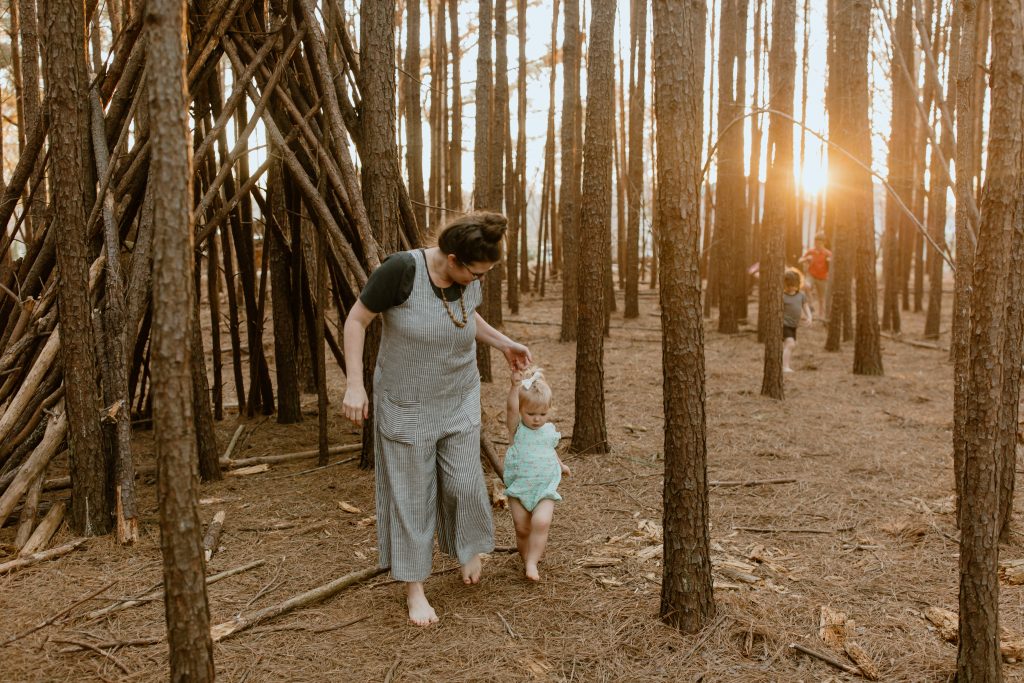
Charlotte Mason wrote: “In this time of extraordinary pressure, educational and social, perhaps a mother’s first duty to her children is to secure for them a quiet and growing time, a full six years of passive receptive life, the waking part of it for the most part spent out in the fresh air.”
Giving young children ample amounts of time outside is a top priority for me. I could talk for hours about the benefits of outdoor play for children, but here are a couple. Time in nature develops the habit of attention as they study a leaf closely or crouch down to watch a bug walk along. As children play in an unstructured environment in nature, their muscles of creativity and problem solving are being strengthened. When possible, I aim for four or more hours each day of unstructured outside exploration for all of my children. Depending on the weather and circumstances, that is not always possible, but it is a goal.
How we implement this:
- Defining a safe space outdoors – It can be tricky to fit in hours of time in nature along with homeschooling the older children and all the other responsibilities that come along with caring for a home. I have found that having a safe outdoor space for the little ones to go out without me right there with them, but within my sight and hearing range is essential. It doesn’t have to be fancy or large, but somewhere safe that they can get that unstructured play in while I finish the dishes or read aloud.. For us, it is right outside our back door. Over the years we have had a sandbox, mud kitchen, and tree fort area that the little ones can play in all day. On top of this, we often spend afternoons or evenings on hikes or in the woods behind our house. Every Friday, we spend the entire morning out in nature with friends from our Wild + Free group.
What about academics in the early years?

Our family has chosen to delay formal education until around age six. Delaying formal academics doesn’t mean delaying learning, it just means we allow our children to learn in a way that is natural and organic until that age. There are many ways we can facilitate learning the alphabet, numbers, and many other subjects for young children even if they aren’t using a pencil and workbooks. Some ways are exploring a moveable alphabet, counting as you skip rocks or crack eggs, and reading living books about a variety of subjects! We also do puzzles, watercolor, play board games, and just simply talk about everything they are experiencing. During all of this, they are learning!
While not necessary, following a guide to help you naturally invite your children into learning can be fun and helpful. If you use a preschool curriculum to structure your learning experiences, I recommend finding one that prioritizes these intentions in gentle and inviting way. Treehouse Story School: Preschool is a gentle, literature-based preschool curriculum that invites children to learn through the themes in stories they love. Each week will focuses on a picture book, inviting children into connection and learning through music and movement, play-based narration, alphabet and number play, motor skills, practical life development, crafts, and baking together.
Beloved early learning resources from Treehouse Schoolhouse
Are you looking for learning resources or learning material for toddlers or preschoolers in your home? Consider these best-selling products from Treehouse Schoolhouse that offer a gentle invitation to learning for small children.
Treehouse Story School: Preschool

Treehouse Story School: Preschool is 32-weeks of gentle, literature-based curriculum designed for ages 2.5-5 years. This preschool curriculum that invites children to learn through the themes in stories they love. Each week will focus on a picture book, inviting children into connection and learning through music and movement, play-based narration, alphabet and number play, motor skills, practical life development, crafts, and baking together.
It would be a great fit for your toddler or preschooler if you are looking to incorporate multi-sensory, play-based learning while introducing them to timeless stories.
From toddler through upper preschool, this curriculum can be used year after year as you dive deeper into beloved, classic stories your family will cherish.
Stay tuned for more details – coming this summer! Preview a free week here.
Daily Rhythm Bundle
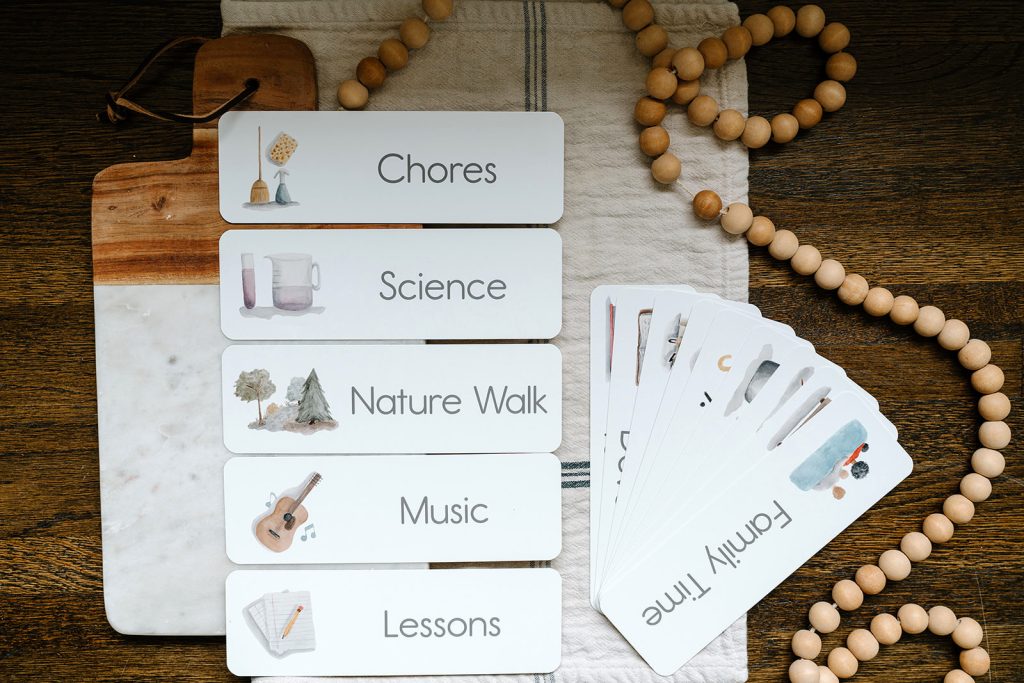
Children are highly visual–they can feel particularly out of control when they don’t know what to expect of their day. That’s why we recommend using a visual schedule to support your children from the time they are very young.
Rather than trying to stick to a rigid schedule, this set helps you create a general rhythm for your days. The daily rhythm worksheet is laminated and dry erase and the cards can be moved around offering you flexibility and adaptability.
Morning Time Bundle

This interactive, reusable set focuses on weather, seasons, moon phase, temperature, weather-appropriate clothing, date and time, and reading a calendar. With this daily bundle, your child will practice the skills of handwriting, tracing, copywork, and telling time. I recommend you print these materials and place them inside of a Morning Time Menu or dry-erase sleeve. Using dry-erase markers, your child can fill this bundle out over and over again.
We also offer a version of the Morning Time Bundle for those in our community who live in the Southern Hemisphere.
What do you love to do with your children during the early years? Share your experience in the comments below.

![Creating a Daily Preschool Schedule [Quiz and Schedule PDF]](https://storage.googleapis.com/treehouse-schoolhouse-media-dev/0c19c1c0-gtb2408.jpg)
